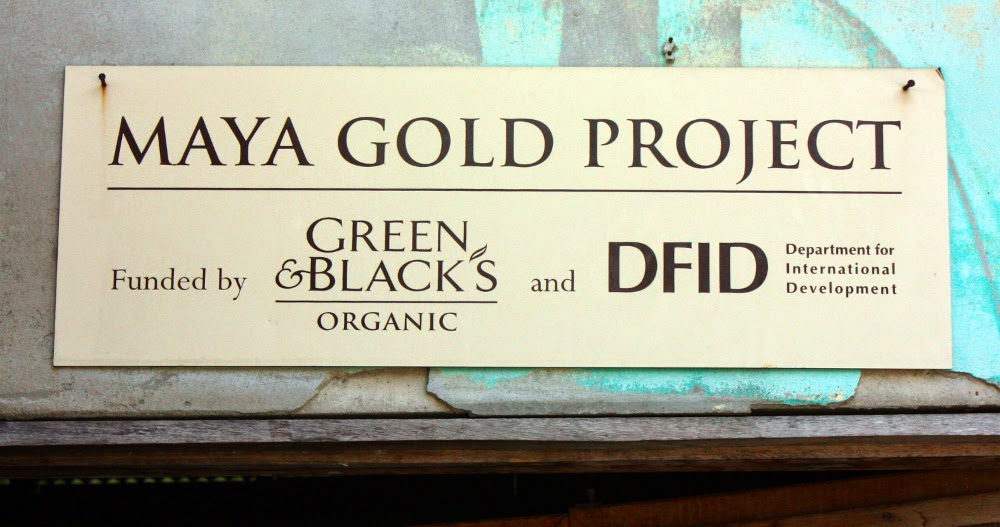The of Best Intentions Not Always Enough: The First-Hand Perspective of a Fairtrade Farmer
Toledo Cacao Growers Association Office
As a professed cacao geek, one of the most exciting outings of our chocolate trip to Belize was a meeting with the former Association Chair of the Toledo Cacao Growers Association (“TCGA”).
Sitting at a long conference table in a small room, we could have been anywhere in the world. But here we were in Punta Gorda, the capital of the Toledo District, meeting with someone from a Fairtrade-certified farmers’ cooperative. After years of doing my best to answer customers’ questions about fair trade, I was sitting in the same room with a member farmer from a fair trade group. My moment had finally come.
Our host was the former Association Chair from 1992-1997, Mr. Justino Peck, himself a cacao farmer. I really appreciated his candor. He wasn’t trying to sugar-coat his experiences or how he views the future. He was incredibly honest and forth-coming, providing us with a brief glimpse into the window of his livelihood.
He spoke eloquently about the history of the TCGA, offering an illustration of how difficult it is to be an organization dependent upon outsider funding. It was hard not to be sympathetic with this man and his fellow farmer members. Outsiders come in and tell them what to do, and then leave after a few years. The farmers are left to their own devices after the projects end, a practice that has taught them not to rely on outsiders.

Mr. Justino Peck, former Association Chair
The Beginning of the TCGA: USAID Arrives in Belize
In the 1970’s, farmers in Belize were growing cacao mostly for their own use. In 1984 USAID came to Belize to work with farmers to encourage commercial cacao farming. It probably won’t surprise you to find out that Hershey was involved in this interest in Belize. Mr. Peck, a teacher by training, decided to leave his job in 1984 and begin planting cacao.
USAID ran this project from 1984-1989. They encouraged farmers to abandon their traditional organic methods and begin using chemical “inputs”, a.k.a., fertilizer and pesticides. They introduced the farmers to Hershey as a buyer, who offered better prices. After only five years, the project came to an end and USAID left Belize.
Mr. Peck pointed out that while a cacao tree may begin producing pods after 3-5 years, it doesn’t reach maturity for ten years. Planting cacao is an investment for the Maya, one that they expect to produce for 80-100 years. USAID left after five years, leaving the farmers high and dry before their plants had reached maturity. The farmers jettisoned the fertilizers and pesticides and returned to the organic farming traditions of their ancestors. While this was good for them in the long-term, the short term was about to get ugly.
Between 1990 and 1991, the bottom fell out of the cacao market. Prices went from $0.85/lb to $0.25/lb. Most farmers looked for jobs in the citrus, banana or shrimp industries. Mr. Peck, however, stuck with cacao.

It all started with Green & Black's
Green & Blacks Purchases its First Fairtrade Cacao
Mr. Peck became the first chairman elected to lead the TCGA in 1992. When a contact at the Ministry of Agriculture connected him with a buyer looking for organic cacao, he felt it was important for the TCGA to bind itself to one buyer to try to prevent the farmers from failing. Based on the farmers’ past experiences with the volatility of the cacao market, he felt the farmers would be better off signing contracts with specific buyers. Without a contract, it’s the farmers who fail in a down market, not the buyers.
In November 1993 the farmers agreed to sign a 3-year, binding contract with Whole Earth Foods Company LTD, a Green & Blacks joint venture. The farmers were happy with the negotiated price, and it gave them income certainty, something they’d never had with cacao. They produced 16,000 pounds of cacao in their first year, which, while significant for them, was only a small fraction of the cacao used in Green & Blacks’ production of their Maya Gold chocolate bar. It was Green & Blacks first purchase of Fairtrade cacao, and it was the beginning of a good relationship for the TCGA.
In 2005 Cadbury purchased Green & Blacks, and then in 2010 Cadbury was taken over by Kraft foods (now part of Mondelēz International). This is when things changed. While Kraft still purchases a significant amount of cacao from the TCGA, Kraft does not offer the rolling 5 year contracts that Green & Blacks offered in the past. Like most large chocolate companies, Kraft negotiates the price on every shipment based on world market rates at the time. If it weren’t for the booming interest in artisan craft chocolate, these farmers would be back to square one without a stable income.

Chocolate makers and chocophiles outside TCGA office and warehouse
The Impact of the Craft Chocolate Movement
The craft chocolate movement around the world, and, particularly in the US, has had an impact upon the Belize cacao market.
When Maya Mountain Cacao (MMC) set up shop in the Toledo District in 2010, the TCGA was skeptical. Here was another outside group that the TCGA didn’t expect to stick around. During my stay in Belize I heard that the TCGA had discouraged farmers from selling to MMC, telling the farmers that MMC wouldn’t be around for long. Given the track record of outsiders, can you blame them for saying this?
Fast forward four years, and MMC is going stronger than ever and expects to be around for a long time.
So what’s different? There’s been a fundamental change in the American chocolate market. American chocolate lovers are becoming chocophiles. They’re learning to appreciate single-origin chocolate made from organic, fine flavor cacao that has been well fermented, and they understand that with this increase in quality comes an increase in price. Demand for organic fine flavor cacao can only be expected to continue to grow.
I considered sharing this thought with Mr. Peck, but I decided I wouldn’t. After his experiences with outsiders leaving, I decided he and the other farmers would need to figure this out for themselves through personal experiences that would only come with time.
Stay tuned for Part II of the story of the TCGA. Next week, The Challenging Road to Self Sufficiency for a Fairtrade Association.

